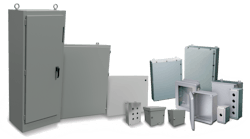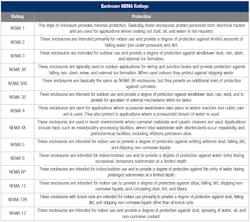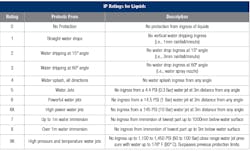Specifying the right electrical enclosure
The humble electrical enclosure can be found most anywhere in public areas, buildings and industrial settings. In fact, these apparently simple boxes are so ubiquitous as to go unnoticed unless one is on the lookout for them. Regardless of how common and basic electrical enclosures may seem, they must be carefully selected to protect people around them and equipment within them.
Electrical enclosures house—and sometimes include interfaces for—all types of electrical power, instrumentation, automation and other electronic devices. These expensive and critical devices could be damaged if outside moisture and dirt reaches them, or people could be harmed if they are not protected from the electrical energy within the enclosures.
A properly selected and installed enclosure will provide a long lifetime of service, maintaining the required integrity and appearance. Selecting the proper enclosure requires a series of decisions and sometimes a balancing act among different variables. There is not a perfect checklist for doing so, because many decisions impact other choices, making the selection process iterative. This article discusses some steps for designers to follow so they can ensure all the right variables have been considered when specifying an enclosure.
Start with codes, standards and specifications
Designers should begin by understanding all applicable codes, standards and specifications. For instance, the National Electrical Code or local codes may have working space requirements that will impact control panel sizing and location decisions.
The primary standard for enclosure protection classification used in North America is the rating system established by the National Electrical Manufacturers Association (NEMA). Elsewhere in the world, ingress protection (IP) codes based on International Electrotechnical Commission (IEC) standards are more common. Underwriters Laboratories (UL) and the Canadian Standards Association (CSA) investigate and list enclosures using NEMA and IEC standards as guidelines. In turn, UL-certified panel fabrication shops can build and list assemblies using UL list enclosures and components.
Other specifications include additional project requirements, which may be created by an end user or their design firm. These can call for materials or accessories over and above what the code or other standards would require, or they may require or disallow certain products.
The form factor of a box
Electrical enclosures are available in various styles to perform required functions. The simplest function is a passive box that keeps the interior protected from the exterior, and vice versa (Figure 1). More complicated designs require enclosures to support hardwired devices like pushbuttons and instruments on the face, or more complex digital displays.
Some enclosures are arranged into a desktop form factor for use in a control room, while others are modular and expandable, or quite small for field installation. Some common styles are:
- Wall-mount
- Floor-mount (with legs)
- Freestanding (enclosure extends all the way to the floor)
- Consoles, consolets and pushbutton enclosures (for housing pilot devices for operators use)
- Junction boxes and wireways (to facilitate wiring)
- Slope top (for sanitary use)
Even more advanced configurations are possible, such as enclosures with windows, front and back dual access, and for flush-mounting into a wall.
Sizing an enclosure is a task of balancing internal space, external installation room and cost. The enclosure obviously must be big enough to house the contents with proper space tolerances, and interior space must be sufficient for fabricators and maintenance personnel. However, the enclosure maximum size is limited by where it will be installed and cost. Many enclosures include subpanels, which is where installers mount devices. When field space is constrained, designers must choose smaller enclosures and are often required to use more complex arrangements to fit everything in a limited area.
One caution about sizing enclosures is that designers should carefully review the product engineering drawings, as opposed to only using the catalog or website description. These descriptions may be “nominal” dimensions, but the actual available space may be different, or there may be obstructions like stiffeners within the doors. Subpanels, sidepanels and some accessories can create unexpected interferences within a design and must be considered.
Once the enclosure style and size are generally determined, designers can consider the necessary ratings.
Ratings and construction materials
Understanding the environment in terms of dirt, water, temperature and chemicals is key to determining the level of protection required for an enclosure. NEMA ratings can be summarized in a single table. IEC ratings are determined by combining one number from the “solids” table and one from the “liquids” table to determine the effective rating (Table 2a/b/c). Note that adding a suffix of “K” to an IP rating indicates the enclosure has been tested with high-pressure water jets, which is important for industries like food, beverage and pharmaceutical. Also note that while some enclosures may carry a NEMA and an IP rating, there is no conversion between the two systems.
To properly select an enclosure for an application, it is necessary to know what environmental hazards the enclosure must protect against, and what NEMA rating or IP code provides the desired level of protection. Some accessories, like drip shields, can improve the enclosure performance in falling water environments.
Closely related to NEMA and IP ratings are the enclosure materials of construction. Common enclosures are often made from metal:
Painted carbon steel: These are basic and economical but are not very resistant to chemicals and scratches.
Stainless steel: These are very durable and are available in several alloys (304, 316 and 316L) depending on the type of exposure expected. However, they are progressively more costly as the alloy grade increases, and they can be harder to metalwork than carbon steel.
Aluminum: Can provide a good combination of durability and value, and they work well in high-heat areas.
Many non-metallic options are strong, easy to work with, withstand chemicals and weather, and can even include windows:
- Fiberglass reinforced polyester
- Polycarbonate
- PVC
- Thermoplastic ABS
Another benefit of non-metallic enclosures is they work well with the increasing number of wireless devices installed within enclosures because they do not attenuate the Bluetooth or Wi-Fi signals nearly as much as metallic enclosures.
Remember thermal management
Each of the preceding design considerations impact each other, and they all affect the thermal management of an electrical panel design. Components in the panel usually generate heat and have maximum and minimum operating temperatures.
Enclosures will dissipate more or less heat depending on varying materials and the ambient temperature, with direct sunlight a significant source of external heat. Heat can be managed with venting, fans, vortex coolers or air conditioning if the environment and application allow for it. Sometimes an enclosure material can be changed, or the enclosure can be upsized so it dissipates enough heat.
On the other hand, heating devices may need to be installed. Sometimes this is to keep the enclosure at a desired operating temperature in frigid environments. More typically, heating is used to keep the enclosure temperature at a level where moisture and associated corrosion are mitigated.
Check the accessories
Basic enclosures may arrive complete, or perhaps a backpanel must be ordered separately. More complex modular enclosures may require specification using several part numbers. In addition, many other types of accessories are available and could be needed for an application.
A common accessory, especially for enclosures installed in public spaces, are locking provisions to protect against unauthorized access. Screw covers and clamping covers require tools to open, which discourages access. Special manufacturer keying systems and padlock-capable latches provide even better security (Figure 3).
Some designs call for electrical interlocks that are wired so personnel can only open the enclosure when specific actions are taken, such as de-energizing the equipment or using a special key-operated contact switch.
Options lead to choices
Properly selecting an electrical enclosure for your application doesn’t need to be complicated, but it does require careful investigation and decision making. Also, many of the choices relating to enclosure types, sizes, ratings, materials and thermal management impact each other. This means the enclosure selection process may require a few iterations to arrive at the right set of features.
Once the basics are determined, numerous accessories are available to tailor a design to exactly match the need. Users can add swing-out panels, barriers to separate power and control sections, window kits, folding shelves, wire/cable management systems, and more to elevate the functionality, safety, and user-friendliness of any design.
Time taken in the specification and selection process will ensure many years of safe and trouble-free service.
Jim Krebs is a technical marketing engineer at AutomationDirect. He began his career as a field service engineer and has more than 32 years of experience working with industrial equipment and controls for the manufacturing, water treatment, wastewater treatment, food and beverage, and pulp and paper industries. Leveraging his experience with service, installation and training in industry, he currently develops technical manuals, training documents and reference material for products, industrial instrumentation, processes and software help files.




